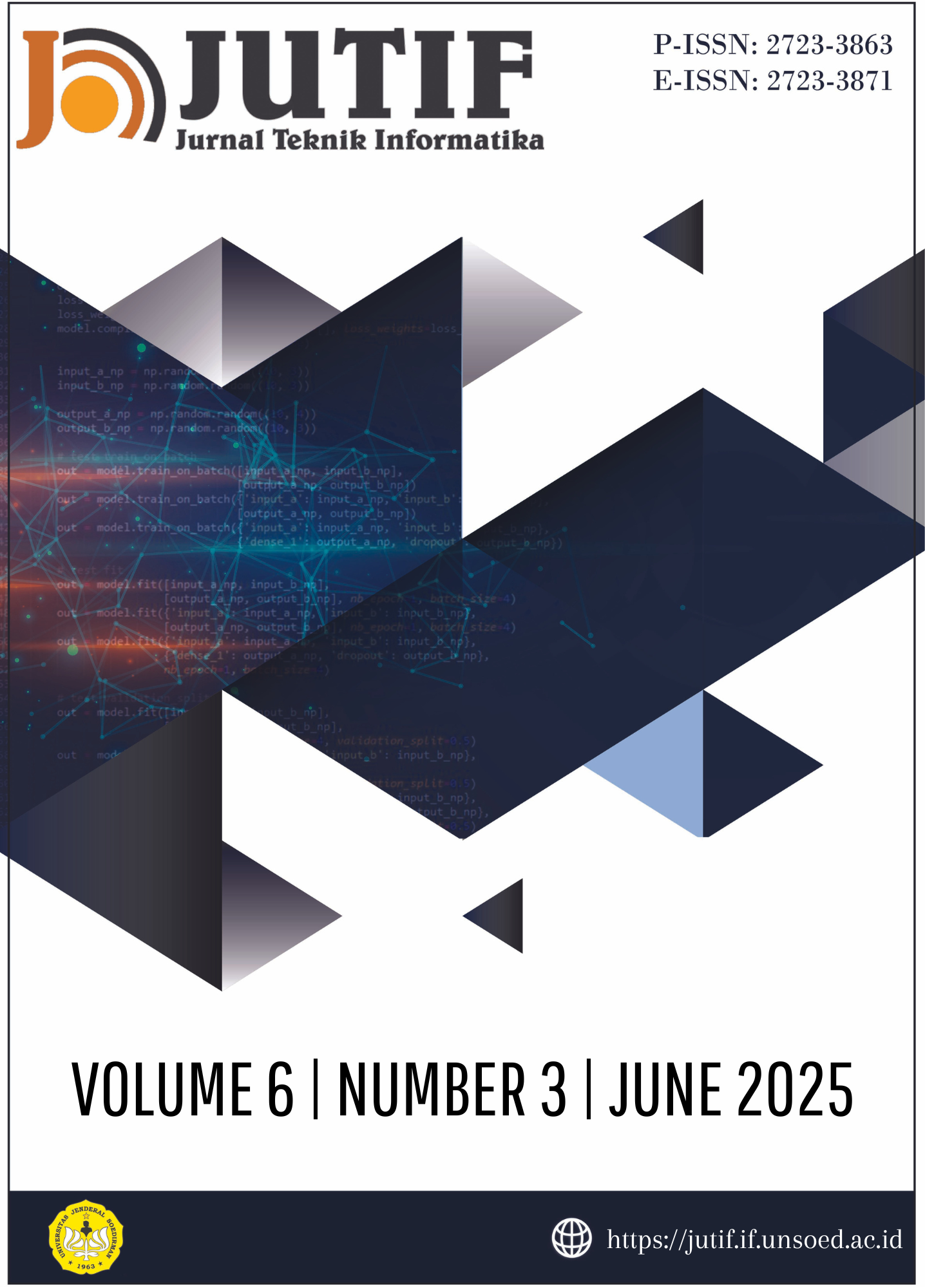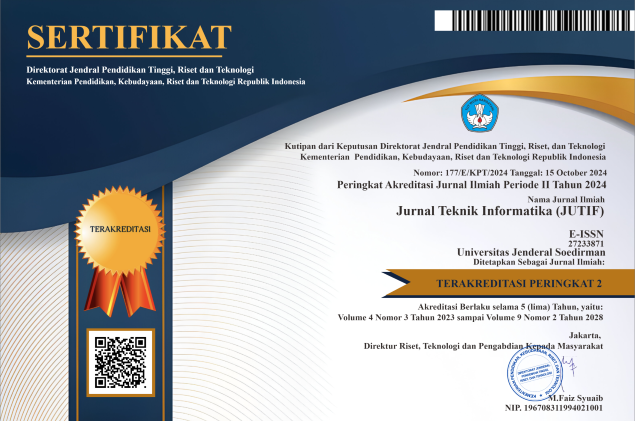Optimization Artificial Neural Network (ANN) Models with Adam Optimizer to Improve Customer Satisfaction Business Banking Prediction
DOI:
https://doi.org/10.52436/1.jutif.2025.6.3.4776Keywords:
Adam optimizer, Artificial neural network, Customer satisfaction, Optimization, Predictive modelingAbstract
Customer satisfaction prediction is critical for business banking to retain clients and optimize services, yet existing models struggle with imbalanced data and suboptimal convergence. Traditional approaches lack adaptive learning mechanisms, limiting accuracy in real-world applications. This study developed an optimized Artificial Neural Network (ANN) model using the Adam algorithm to improve prediction accuracy for banking customer satisfaction. We trained an ANN on the Santander Customer Satisfaction Dataset (76,019 entries, 371 features) with Adam optimization. Preprocessing included normalization, removal of quasi-constant features, and an 80-20 train-test split. Adam’s adaptive learning rates and momentum were leveraged to address gradient instability. The model achieved 95.82% accuracy, 99.99% precision, 95.83% recall, a 97.87% F1-score, and 0.82 AUC, outperforming traditional optimizers like SGD. Training loss reduced by 30% with faster convergence. This work demonstrates Adam’s efficacy in handling imbalanced banking data, providing a scalable framework for customer analytics. The results advance computer science applications in fintech by integrating adaptive optimization with deep learning for high-stakes decision-making. This research contributes to the growing body of knowledge in machine learning applications for business analytics and provides a valuable framework for improving customer satisfaction prediction models in various industries and the advancement of deep learning applications in business intelligence, particularly in banking service quality prediction.
Downloads
References
J. Kaur, V. Arora, and S. Bali, “Influence of technological advances and change in marketing strategies using analytics in retail industry,” International Journal of System Assurance Engineering and Management, vol. 11, no. 5, pp. 953–961, 2020, doi: 10.1007/s13198-020-01023-5.
Y. Beeharry and R. Tsokizep Fokone, “Hybrid approach using machine learning algorithms for customers’ churn prediction in the telecommunications industry,” Concurr Comput, vol. 34, no. 4, 2022, doi: 10.1002/cpe.6627.
S. M. Shrestha and A. Shakya, “A Customer Churn Prediction Model using XGBoost for the Telecommunication Industry in Nepal,” in Procedia Computer Science, Elsevier B.V., 2022, pp. 652–661. doi: 10.1016/j.procs.2022.12.067.
S. Torkzadeh, M. Zolfagharian, A. Yazdanparast, and D. D. Gremler, “From customer readiness to customer retention: the mediating role of customer psychological and behavioral engagement,” Eur J Mark, vol. 56, no. 7, pp. 1799–1829, Jul. 2022, doi: 10.1108/EJM-03-2021-0213.
K. G. M. Karvana, S. Yazid, A. Syalim, and P. Mursanto, “Customer Churn Analysis and Prediction Using Data Mining Models in Banking Industry,” in 2019 International Workshop on Big Data and Information Security, IWBIS 2019, 2019, pp. 33–38. doi: 10.1109/IWBIS.2019.8935884.
S. Anwar, D. A. Kurnia, A. Faqih, and S. R. Sari, “Prediksi Hasil Belajar Hybrid Menggunakan Artificial Neural Network Dengan Multilayer Perceptron,” JURIKOM (Jurnal Riset Komputer), vol. 9, no. 5, p. 1591, Oct. 2022, doi: 10.30865/jurikom.v9i5.5024.
M. Maduna, A. Telukdarie, I. Munien, U. Onkonkwo, and A. Vermeulen, “Smart Customer Churn Management System Using Machine Learning,” in Procedia Computer Science, Elsevier B.V., 2024, pp. 552–558. doi: 10.1016/j.procs.2024.05.139.
S. J, Ch. Gangadhar, R. K. Arora, P. N. Renjith, J. Bamini, and Y. devidas Chincholkar, “E-commerce customer churn prevention using machine learning-based business intelligence strategy,” Measurement: Sensors, vol. 27, p. 100728, Jun. 2023, doi: 10.1016/j.measen.2023.100728.
J. Hadden, A. Tiwari, R. Roy, and D. Ruta, “Computer assisted customer churn management: State-of-the-art and future trends,” Comput Oper Res, vol. 34, no. 10, pp. 2902–2917, 2007, doi: 10.1016/j.cor.2005.11.007.
B. Prabadevi, R. Shalini, and B. R. Kavitha, “Customer churning analysis using machine learning algorithms,” International Journal of Intelligent Networks, vol. 4, pp. 145–154, Jan. 2023, doi: 10.1016/j.ijin.2023.05.005.
H. Peng, F. Long, and C. Ding, “Feature selection based on mutual information: Criteria of Max-Dependency, Max-Relevance, and Min-Redundancy,” IEEE Trans Pattern Anal Mach Intell, vol. 27, no. 8, pp. 1226–1238, 2005, doi: 10.1109/TPAMI.2005.159.
A. De Caigny, K. W. De Bock, and S. Verboven, “Hybrid black-box classification for customer churn prediction with segmented interpretability analysis,” Decis Support Syst, vol. 181, Jun. 2024, doi: 10.1016/j.dss.2024.114217.
A. Keramati, H. Ghaneei, and S. M. Mirmohammadi, “Developing a prediction model for customer churn from electronic banking services using data mining,” Financial Innovation, vol. 2, no. 1, 2016, doi: 10.1186/s40854-016-0029-6.
I. Piriyakul, S. Kunathikornkit, and R. Piriyakul, “Evaluating brand equity in the hospitality industry: Insights from customer journeys and text mining,” International Journal of Information Management Data Insights, vol. 4, no. 2, Nov. 2024, doi: 10.1016/j.jjimei.2024.100245.
A. Dingli, V. Marmara, and N. S. Fournier, “Comparison of deep learning algorithms to predict customer churn within a local retail industry,” Int J Mach Learn Comput, vol. 7, no. 5, pp. 128–132, 2017, doi: 10.18178/ijmlc.2017.7.5.634.
S. Barua, M. M. Islam, X. Yao, and K. Murase, “MWMOTE - Majority weighted minority oversampling technique for imbalanced data set learning,” IEEE Trans Knowl Data Eng, vol. 26, no. 2, pp. 405–425, 2014, doi: 10.1109/TKDE.2012.232.
O. F. Seymen, O. Dogan, and A. Hiziroglu, Customer Churn Prediction Using Deep Learning, vol. 1383 AISC. 2021. doi: 10.1007/978-3-030-73689-7_50.
J. Pamina et al., “An effective classifier for predicting churn in telecommunication,” Journal of Advanced Research in Dynamical and Control Systems, vol. 11, no. 1 Special, pp. 221–229, 2019.
A. De Caigny, K. Coussement, and K. W. De Bock, “A new hybrid classification algorithm for customer churn prediction based on logistic regression and decision trees,” Eur J Oper Res, vol. 269, no. 2, pp. 760–772, 2018, doi: 10.1016/j.ejor.2018.02.009.
S. W. Fujo, S. Subramanian, and M. A. Khder, “Customer churn prediction in telecommunication industry using deep learning,” Information Sciences Letters, vol. 11, no. 1, pp. 185–198, 2022, doi: 10.18576/isl/110120.
N. I. Mohammad, S. A. Ismail, M. N. Kama, O. M. Yusop, and A. Azmi, “Customer Churn Prediction in Telecommunication Industry Using Machine Learning Classifiers,” in ACM International Conference Proceeding Series, 2019. doi: 10.1145/3387168.3387219.
A. Amin, F. Al-Obeidat, B. Shah, A. Adnan, J. Loo, and S. Anwar, “Customer churn prediction in telecommunication industry using data certainty,” J Bus Res, vol. 94, pp. 290–301, 2019, doi: 10.1016/j.jbusres.2018.03.003.
T. Mandhula, S. Pabboju, and N. Gugulotu, “Predicting the customer’s opinion on amazon products using selective memory architecture-based convolutional neural network,” Journal of Supercomputing, vol. 76, no. 8, pp. 5923–5947, 2020, doi: 10.1007/s11227-019-03081-4.
E. Domingos, B. Ojeme, and O. Daramola, “Experimental analysis of hyperparameters for deep learning‐based churn prediction in the banking sector,” Computation, vol. 9, no. 3, 2021, doi: 10.3390/computation9030034.
Y. Luo, J. Zhong, W.-L. Liu, and W.-N. Chen, “Automatic Business Location Selection through Particle Swarm Optimization and Neural Network,” in 2023 15th International Conference on Advanced Computational Intelligence, ICACI 2023, 2023. doi: 10.1109/ICACI58115.2023.10146157.
A. K. Shahade, K. H. Walse, V. M. Thakare, and M. Atique, “Multi-lingual opinion mining for social media discourses: an approach using deep learning based hybrid fine-tuned smith algorithm with adam optimizer,” International Journal of Information Management Data Insights, vol. 3, no. 2, 2023, doi: 10.1016/j.jjimei.2023.100182.
A. Amin et al., “Comparing Oversampling Techniques to Handle the Class Imbalance Problem: A Customer Churn Prediction Case Study,” IEEE Access, vol. 4, pp. 7940–7957, 2016, doi: 10.1109/ACCESS.2016.2619719.
N. Grimbald and T. Chelsea Mah, “Bank Marketing and Its Effects on Customer Retention in Microfinance in Yaounde, Cameroon,” Business and Economic Research, vol. 13, no. 1, p. 57, Mar. 2023, doi: 10.5296/ber.v13i1.20331.
S. Agrawal, A. Das, A. Gaikwad, and S. Dhage, “Customer Churn Prediction Modelling Based on Behavioural Patterns Analysis using Deep Learning,” in 2018 International Conference on Smart Computing and Electronic Enterprise, ICSCEE 2018, 2018. doi: 10.1109/ICSCEE.2018.8538420.
S. Momin, T. Bohra, and P. Raut, Prediction of Customer Churn Using Machine Learning. 2020. doi: 10.1007/978-3-030-19562-5_20.
Additional Files
Published
How to Cite
Issue
Section
License
Copyright (c) 2025 Yahya Nur Ifriza, Yusuf Wisnu Mandaya, Ratna Nur Mustika Sanusi, Hendra Febriyanto, Abdul Jabbar, Azlina Kamaruddin

This work is licensed under a Creative Commons Attribution 4.0 International License.



























